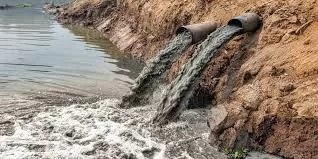What Is Industrial Runoff and Why Does It Matter?
Industrial runoff is the discharge of chemical effluents into water sources, causing pollution. This pollution of water sources impacts both human and environmental health (Singh et al., 2023). Runoff commonly occurs in industrial and agricultural settings such as farms, factories, or mine sites. Industrial runoff is a problem because it introduces toxic chemicals into sensitive waterways, harming aquatic life. Agricultural runoff alters nutrient loads, which can create algal blooms, depleting oxygen and reducing waterway viability (KCI Admin, 2023).

Source: The Green Woman
Released into waterways the world over, there are many thousands of chemicals used in industries and agriculture, from fertiliser production, to cookware and food production, to washing detergents (Elite Liquid Waste, 2025). Many of these chemicals are unregulated, meaning there is no knowledge of the effects of these chemicals not only on human health, but also on wildlife and the environment. One unregulated chemical, perfluorooctanoic acid (PFOA), underscores the need for regulation of these chemicals and highlights the importance of Values-Based Innovation. Values-Based Innovation drives the creation of resources that align with efforts to deliver more ethical and thrivable outcomes, promoting healthy living and environmentally safe products. This then promotes Strong Sustainability, the viewpoint that nature is essential and irreplaceable, ensuring that ecosystems and ecosystem services are maintained for future generations to enjoy. Both Values-Based Innovation and Strong Sustainability are Foundational Focus Factors of THRIVE.
Forever Chemicals
PFOA is a ‘Forever Chemical’, one of the 10,000 artificial perfluoroalkyl and polyfluoroalkyl substances (PFAS) that exist. These chemicals are highly toxic and do not break down in the environment, hence the name (Kluger, 2023). At the current rate, it would take over 40,000 years to regulate every PFAS chemical, to ensure that these chemicals are safe for use and consumption, while not affecting the environment, and breaking down within a reasonably defined timeframe (CHEM Trust, 2025).
The Origin of the Teflon Scandal: DuPont and PFOA
PFOA was first created by 3M, originally called the Minnesota Mining and Manufacturing Company, an American conglomerate that produces a wide variety of household products, in the 1940s. PFOA was used in non-stick cookware, such as Teflon (ProPublica, 2024). DuPont began buying PFOA from 3M in the 1950s for use in Teflon and cosmetic products (Manufacturing Dive, 2023).
In the 1990s, a farmer in rural West Virginia, USA, contacted a lawyer, Robert Bilott, about his dead and dying livestock. He claimed they had been poisoned by the industrial runoff coming from the nearby chemical waste dump site (Bilott, 2019). This site was recently purchased by DuPont and used for dumping waste (The Green Woman Ltd, 2024). The claim was that this waste flowed into the creek that ran through their property, contaminating their drinking water and poisoning the cattle (Right Livelihood, 2025). These cattle were experiencing a range of symptoms, including black teeth, kidney failure, and incontinence. Calves were weak, often struggling to walk, and many were dying (Kluger, 2023). DuPont, however, denied any adverse effects of PFOA.
How bilott took down dupont
Bilott began investigations and found startling results in the bloodwork of the cattle. It was clear to Bilott that there was a connection between these chemicals and the health of the livestock. A court order gave Bilott access to the DuPont chemical records. Not only was a link uncovered, but the records showed that DuPont were aware of the hazards associated with PFOA. DuPont had had awareness of the risks associated with PFOA for decades, yet, they not only continued its use but actually increased it, going as far as to build their own manufacturing company. Right up until the effects of PFOS went public, DuPont continued to invest in PFOS (Right Livelihood, 2025).

Ultimately, DuPont’s own research gave Bilott the evidence he needed to take down DuPont (Gaber et al., 2023). DuPont had done several tests on rodents decades prior, finding significant negative effects, including kidney issues and death (ChemTrust, 2025). However, DuPont had ignored these results and continued to maintain that there were no adverse effects from using PFOA. DuPont even synthesised a new chemical, similar to PFOA, but with reduced environmental and health effects, given its ability to break down more easily. The board of DuPont, however, decided to continue using the original PFOA (Gaber et al., 2023).
Health Impacts of PFoa Exposure on Communities
PFOA was first found in the blood of townspeople in 1997, but the company 3M denied the evidence until 2000. Similarly, DuPont covered up evidence of the impacts of PFOA for decades, launching smear campaigns and refuting the science. PFOA lasts a long time in the environment and causes a multitude of illnesses when ingested (Christensen & Yang, 2019). These issues include kidney cancer, birth defects, thyroid disease, reduced vaccine efficacy, chronic illness, and immune dysfunction (ChemTrust, 2025; Christensen & Yang, 2019).
PFOA also causes significant harm to livestock, particularly those raised for meat, with symptoms in animals similar to human symptoms. The PFOA in animals, then consumed by humans, increases the levels of PFOA in the body, exacerbating the issue. Emissions from PFOA and other PFAS are also difficult to control owing to their long lifespan and resistance to degradation (Evich et al., 2023). Their ability to travel long distances through the air and water also impairs their controllability.
the dupont reaction
Rather than taking the more economically sensible route of settling early, DuPont chose to contest each claim individually. This strategy significantly prolonged the legal process, increased costs, and ultimately resulted in major financial setbacks. Eventually, DuPont merged with Dow Chemical to form DowDuPont, which then later split into three separate companies. In an ironic twist, the new DuPont now markets itself as a leader in clean water solutions. They create innovations for healthy drinking water (DuPont, 2025).
Legal Battles and Public Outcry Against DuPont
When the truth about PFOA became public knowledge, there was public outcry. PFOA was everywhere, in people’s blood; it was even present in those who had no connection to DuPont, either to the company itself or to proximity to the dumping ground. People were left wondering how much damage had been done to both their bodies and the environment before they were even aware. It ended in Bilott heading a personal injury lawsuit for each PFOA sufferer, all 7 million of them (Gilliam, 2022). These health effects included cancer, kidney disease, and birth defects among a vast array of illnesses.
The scandal created worldwide outcry and created backlash against the environmental and human health impact of PFOA. Bilott led a charge to sue DuPont for every affected individual in the impacted West Virginia area, approximately 70,000 people. Originally, DuPont challenged every case individually, lengthening the process and costing millions of dollars more in legal fees. However, in 2017, they decided to settle for USD$753 million (Right Livelihood, 2025).
the government response
Other American councils and States are also in the process of launching legal action against DuPont for the presence of PFOA and other PFAS in their communities (Miller, 2025). One of the three demerged companies, Chemours, was charged with environmental damage from industrial runoff in a Dutch court case. This precedent opened the door to legal battles worldwide. DuPont, Chemours, and Corteva settled before going to court in 2023, paying nearly USD$800 million, while 3M negotiated a USD$10 million settlement (The Guardian, 2023).

Source: The Guardian, 2023
This public outcry has denoted the need for stricter chemical regulation, better chemical testing and improved remediation efforts. That PFOA went unregulated for decades has made the American Environmental Protection Agency (EPA) increase its scruitiny of PFAS. It was also a response to accusations it downplayed the severity of PFOA and other PFAS effects (Gillam, 2024).
Global Ripple Effects: Regulatory Changes Worldwide
The outcry from the presence of PFOA and other PFAS chemicals in everyday environments has resulted in stricter regulations on chemical use worldwide, highlighted the loopholes in various toxic chemical acts from across the planet, and built support for sweeping reforms (Right Livelihood, 2025). This includes regulations to limit the production, import, and use of PFAS chemicals, with a particular focus on PFOS.
The UN has recently set standards to regulate the levels of PFAS in drinking water supplies from 2026 (EEA, 2024). The USA has also introduced the Toxic Substance Control Act (TSCA) in an effort to regulate the use and testing of PFAS. The Therapeutic Goods Administration (TGA) of Australia regulates the use of PFAS in Australia, limiting their import, use, and impacts. The Australian State of Queensland was also the first to phase out PFAS in firefighting foam and Aqueous Film Forming Foams (AFFFs) (QLD Government, 2025).
Lessons Learnt and the Future of Chemical Safety
As more people become aware of the dangers associated with chemicals, companies face greater scrutiny to use more environmentally safe chemicals with fewer or zero adverse effects on human health. PFOA and similar chemicals now have heavy regulations, making them difficult for companies to use. The five companies worldwide that manufacture PFOA have, or are currently, phasing out PFOA from their products (Desforges, 2018).
Conclusion and Call to Action (CTA)
Companies must be more transparent about which chemicals are present in products and their effects on both the environment and human health. Relevant authorities must monitor and regulate PFAS within countries. There also needs to be more research into these chemicals and a better understanding of how these chemicals influence the environment and impact human health. Accountability for the effects actions have on environmental health and ensuring the environment is not harmed through material gains is a key pillar of the THRIVE Foundational Focus Factor, Systems Thinking. We need to act now to make changes before it is too late.
Achieving THRIVE goals
The United Nations’ Sustainable Development Goals (SDGs) provide a global framework for tracking and advancing progress towards sustainability. In this instance, SDG3: Good Health and Well-Being, SDG6: Clean Water and Sanitation, and SDG12: Responsible Consumption and Production are relevant in terms of the removal of PFAS from our lives. SDG3 is relevant as PFAS, and particularly PFOS, are detrimental to both human and animal health and the environment. SDG12 ensures companies take responsibility for the harmful effects of their products, rather than continually funding a lack of accountability. However, the SDGs are insufficient, limiting their efficacy. Instead of sustainability, we must advocate for thrivability. Thrivability means humans and nature can flourish together harmoniously, in a world that prospers. This is the goal of THRIVE, a not-for-profit organisation helping to solve many of the world’s issues.
The THRIVE Framework comprises twelve Foundational Focus Factors (FFFs). The FFF Systems Thinking emphasises a holistic, multi‑scale perspective, from individuals to the entire cosmos, so solutions address the full system without causing harm at any level , i.e. preventing harm to humans or the environment through the creation of harmful household chemicals. An example of this is the removal of PFOA from use to prevent environmental degradation and human illnesses. Strong Sustainability, found within the Scope quadrant, and Finite Resources, the Scale quadrant, prioritise ecosystem resilience and regeneration through recognition that natural resources are finite and cannot be exchanged for monetary value. Values-Based Innovation ensures that innovation is grounded in core values, such as environmental health, fairness, and social justice, guiding the development of solutions to complex challenges in a way that aligns with public expectations, values, and demand .
A Thrivable Framework
THRIVE is a not-for-profit organisation committed to improving the world’s issues. Visit the THRIVE website to keep informed on progress on the issues facing the world. Read the many whitepapers, journals, and articles to find in-depth knowledge on current issues. Join the monthly webinar to hear and learn from global experts about thrivable development and work towards thrivability. Subscribe to the THRIVE newsletter to keep informed on the work at THRIVE. Become a volunteer to make a difference today.




















